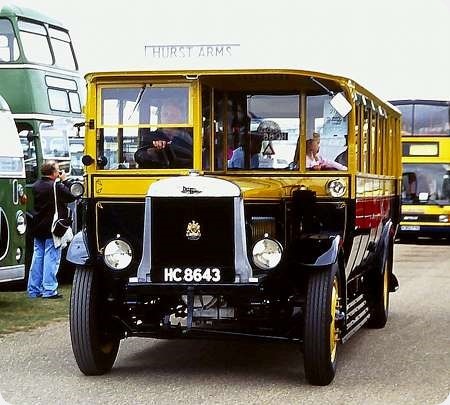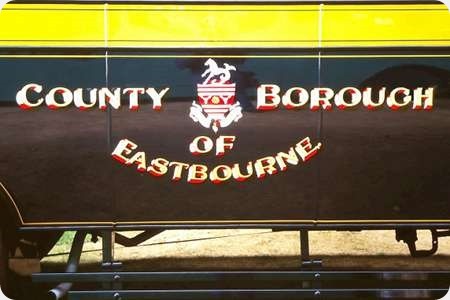
Eastbourne Corporation
1928
Leyland Lion PLSC3
Leyland B32R
HC 8643 is a Leyland Lion PLSC3 some sources omit the P prefix for 1930s Leyland single deckers, but I’ve no idea why, new to the County Borough Of Eastbourne in 1928. It has Leyland’s own B32R body – with door – and we see it arriving at Duxford on 28 September 2003.

This second view shows the fleetname and crest.
Photograph and Copy contributed by Pete Davies
24/11/16 – 09:32
The Lion was a very successful model. The initial letter ‘P’ stood for pneumatic, indicating that it was devised from the outset to accept such tyres rather than being a conversion from solids. The 1926 vintage Lion was designed by J. G. Parry Thomas, who very soon afterwards turned his attention towards the car racing world. It was powered by an overhead valve four cylinder engine of 5.1 litres driving through a four speed crash gearbox, all mounted in a dropped frame chassis, though this was not as low as that on the Rackham designed six cylinder Tiger that appeared in the following year, 1927. According to G. G. Hilditch, who had one at Halifax for a time, the Lion had a top speed of about 25 mph, well above the legal limit of 12 mph that was then in force for buses.
Roger Cox
24/11/16 – 16:44
Thank you, Roger, for the explanation of why some had the P and some did not.
Pete Davies
27/11/16 – 07:36
The PLSC lion was replaced in 1929 by the Lion LT1, and at the same time the Lioness PLC was replaced by the Lioness-Six LTB. The Cub Passenger models (except the REC) carried a P as part of the designation, eg Cub SKPZ2, the first three Gnus were TEP1, although the later design with front end as the TEC1 Steer wagon was the TEC2.
P on post-war Leyland models from the Comet to the Titan meant Passenger.
Stephen Allcroft
27/11/16 – 09:30
I think that we’ve had this discussion about the PD/PS Leyland codes before, Stephen. The generally accepted view is that the ‘P’ stood for ‘post war’ in the passenger models, just as the Daimler ‘V’ in CVG/CVD stood for ‘victory’. Having initiated the ‘P’ classification in 1946, Leyland stuck with it for several years afterwards, by which time the understanding may well have changed to ‘passenger’.
Roger Cox
28/11/16 – 13:34
Roger, it was “generally accepted” for many years that the 27ft Leyland Titan body was the Farington: only it has now been found that was the final 26ft style. Doug Jack for one concludes that Passenger was intended. He had access to the Records. If post war was meant then surely it would have been applied to the freight range as well.
Stephen Allcroft
29/11/16 – 07:47
Stephen, this is a debate that, like the meaning of ‘RT’ and ‘SOS’ continues to run and run. The PD1 was originally designated the TD9 (the TD8 was the projected utility chassis that didn’t materialise), so the subsequent use of ‘P’ for ‘Passenger’ seems illogical, as, indeed does the classification ‘Passenger Double Decker/Passenger Single Decker’. The ‘P’ there is surely redundant, since lorries don’t fall into those categories. Unlike the haulage range, for which a variety of names was adopted, the bulk of the passenger range from Leyland in the early post war years consisted of Titans and Tigers, model names that were carried over from 1939. Given the general public and political mood if the time, I remain convinced that the ‘P’ stood for ‘post war. ‘Passenger Double Decker Type 1 makes no sense when seven versions of the Titan had preceded it. John Banks, for another, agrees with the ‘post war’ understanding, but I am sure that this debate will never be finally settled.
Roger Cox
30/11/16 – 06:57
The menmonics were designed, I’m sure you are aware Roger for the convenience firstly of Leyland production staff and secondly to enable the customers to order the right spare parts. In a way it is immaterial what the letters actually stood for, although we all want to know.
The first Leyland peacetime model was the 12.IB ‘Interim’ Beaver with the same drivetrain as the PD1/PS1 which could on your contention have been the ID1/IS1 as they were also intended as interim models until the “O600 TD9” and its single-deck version became available.
The major difference was the frame, which was dropped for a Passenger application, wheelbases and spring rates then determined the differences between the Tiger and the Titan, so if we disregard names they were always variants of the same passenger model.
If you are right then Leyland designated the Comet bus as Postwar and not the Comet Lorry, although both were launched in 1947, that would be bizarre.
Stephen Allcroft
30/11/16 – 15:49
I am afraid that I remain unconvinced, Stephen. In the cases of the Titan and Tiger, I believe that the change in the initial letter from T to P was intended to mean ‘post war’. The Comet was a haulage model that was adapted to passenger functions, and yes, the ‘P’ did signify ‘passenger in the designation CPO1 etc. However, I think you are reading a degree of consistency in model naming that was probably never there. If your theory is correct, the Comet bus/coach should have been called the PCO1. In the Comet, the letter ‘O’ stood for oil engine, but the same letter ‘O’ was used in export Tiger models such as OPS1 and OPS2, in which case it meant ‘overseas’.
Roger Cox
02/12/16 – 07:06
God Forbid I should accuse any manufacturer of consistency in nomenclature! The OPSU1, 2 and 3 were replaced by the ERT2 3 and 1, while the Leyland designed BUT ETB1 ran concurrent with both. The OPSU3 had been forgotten when the 36 foot Leopard became PSU3, and not L3, the RTC and L1/L2 being replaced by PSU4 in 1967 and PSU5 launched in 1968 which is 23 years after the end of World War two.
https://en.wikipedia.org/wiki/Leyland_Royal_Tiger_PSU
https://en.wikipedia.org/wiki/Leyland_Royal_Tiger_Worldmaster
AEC is presumed to have chosen 2 for semi-automatic transmission and 3 for synchromesh based on the number of pedals, but when a constant mesh gearbox came from Thornycroft, that became 4 (still using three pedals) and the ZF torque converter option on Swift became 5 (still using two). It is more than probable the P used in Swift and Sabre stood for Panther.
Also as the PSUC1 designation came before the Tiger Cub name and that chassis used modified Comet running units rather than anything from the Cub discontinued 12 years earlier that the C originally stood for Comet.
As a purely passenger model, the Tiger Cub had a P at the front, but as demonstrated above, nobody was consistent, the last Comet buses were sold in the early 1970s; here’s a link to one:
//www.sct61.org.uk/lagos1
Stephen Allcroft
Leave a Reply